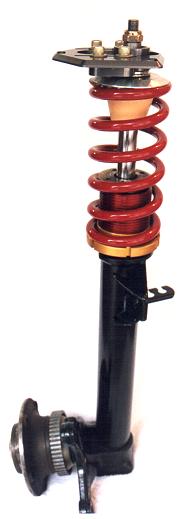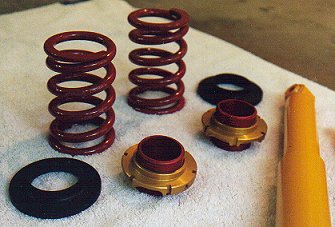 I recently installed a Ground Control suspension on my 1988 M3. I was previously using
an H&R Coil Over kit. That kit was purchased during a time when I still imagined that
I would keep my M3 in a near-stock condition. I felt the H&R coil over kit would offer
a nice compromise between performance and civility - which it does. But as I started
attending more auto-x events in the M3, and then began doing track events, I was feeling
the need for increased stiffness. I had a full race coil over setup on my old Rabbit and
I was starting to miss it.
I recently installed a Ground Control suspension on my 1988 M3. I was previously using
an H&R Coil Over kit. That kit was purchased during a time when I still imagined that
I would keep my M3 in a near-stock condition. I felt the H&R coil over kit would offer
a nice compromise between performance and civility - which it does. But as I started
attending more auto-x events in the M3, and then began doing track events, I was feeling
the need for increased stiffness. I had a full race coil over setup on my old Rabbit and
I was starting to miss it.
Enter Ground Control. They make a kit that allows one to convert the existing front strut to an adjustable spring perch setup using a 2.5" diameter linear race spring. On the rear the factory type "balloon spring" is replaced by a very small 2.25" ID x 5.0" long linear race spring. Since dampers are not an integral part of the kit, one is able to choose what brand to use. In my case I chose Koni Single Adjustable dampers. I had these on my old Rabbit and really liked the way they worked. I was similarly not all that impressed with the Bilstein dampers that are part of the H&R Coil Over kit. There was nothing overtly wrong with the Bilsteins, they just did not feel "right" for my driving taste. |
 The picture at right shows the parts that are supplied for the rear conversion.
You can see the small 2.25" ID springs as well as the cool little adjustable height
springs perches. GC also provides custom made rubber pads to use where the small spring
contacts the upper spring perch.
The picture at right shows the parts that are supplied for the rear conversion.
You can see the small 2.25" ID springs as well as the cool little adjustable height
springs perches. GC also provides custom made rubber pads to use where the small spring
contacts the upper spring perch.
The rear adjustable perches simply sit on top of the steel nub that is part of the factory lower rear spring perch. You then slip in the small race spring with the rubber pad on top, line the spring up with the steel nub on the upper factory spring perch and jack up the control arm in order to attach the rear shock to the trailing arm. Under full droop the rear spring sits loose inside the perches so no compression of the spring is required to install. Some people express concern that the rear spring is not held tightly in-between the rear perches. I have not found this to be an issue. The only time you even notice it is when you jack up the entire rear end of the vehicle. If you just jack up one side then the rear sway bar limits the droop of the rear trailing arm and the spring stays tight. Thus even under aggressive driving conditions, there is almost never a chance for the spring to rattle inside the perches. As was pointed out to me by Ground Control when I brought up this concern, there are plenty of E30's bashing around racetracks across the country using this setup without any problems. If one really wants to keep the rear springs tight in the perches under all conditions then there is one possible solution. One can take a pair of helper springs and have them welded on to the bottom of the main springs. A helper spring is a very short (about 2.0-2.5 inches), very soft (about 10 lbs/in) spring which is made out of flat wire. Thus when the helper springs compresses it forms a very short disc - equivalant to a small spacer about 3/8" thick. Under most conditions the helper spring is completely compressed, but if all load is taken off the main spring then the helper spring extends to keep the main spring pushed tight against the upper spring perch. A helper spring is not to be confused with a tender spring. A tender spring looks the same but it has a much higher rate than a helper spring. Nonetheless, a tender spring is still softer than a main spring. Thus when using a tender spring in conjunction with a stiffer main spring one is able to obtain a "progressive" overall spring rate. This technique is sometimes used in Super Touring, F1 and WRC. Click here for more information regarding helper and tender springs. |